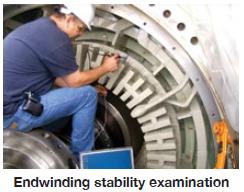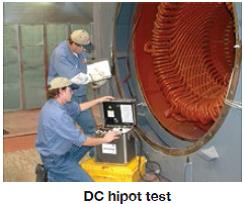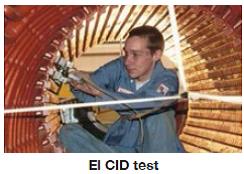Developing, implementing an effective generator assessment program
 Phil Karwowski, Head of Engineering & Technology for EthosEnergy Group, a Wood Group-TurboCare venture, recommended to users during an exclusive webinar for powerplant owner/operators that they consider incorporating a generator assessment program into their next turbine outage. The one-hour program, hosted by the editors at CCJ ONline on October 9, covered a wide range of topics. If you missed the event, view the recording at your convenience.
Phil Karwowski, Head of Engineering & Technology for EthosEnergy Group, a Wood Group-TurboCare venture, recommended to users during an exclusive webinar for powerplant owner/operators that they consider incorporating a generator assessment program into their next turbine outage. The one-hour program, hosted by the editors at CCJ ONline on October 9, covered a wide range of topics. If you missed the event, view the recording at your convenience.
“The generator routinely is overlooked when developing an O&M program,” Karwowski said at the beginning of the session. “As fleets mature, the potential for availability-limiting events caused by the generator continues to increase. However, if an operation and maintenance program is developed early, to coincide with the outage windows of the turbine, forced outages can be minimized and availability requirements managed.”
Inspection frequency. Plants typically perform gas-turbine inspections at fixed intervals. One possible program for an hours-based machine would be a combustion inspection (CI) after 12,000 hours of operation, hot gas path (HGP) inspection at 24K, and a major at 48K. The suggested intervals would apply to units performing starts based maintenance. Karwowski suggested conducting generator inspections at each of these opportunities and he provided details of EthosEnergy’s recommended Generator Assessment Program (GAP) consistent with those times. Details are provided in the box at the end of the article.
But, he stressed, a plant should perform inspections more frequently, if any of the following conditions exist:
- Trend changes in the generator or excitation systems. For example, if there are significant changes in temperature, vibration, leakage, rotor turn shorts, resistance or impedance.
- Generator or excitation system have one or more problems identified by the OEM in a Technical Information Letter (GE), Product Improvement Bulletin (Siemens) or other advisory.
- The unit has had operational issues or failures in the past.
- The unit is being operated in an aggressive environment (moisture, dust, chemical attack, etc).
 Inspection intervals were addressed further in the Q&A part of the webinar, when an attendee asked about intervals for peaking units. “In general, we find the same type of fatigue mechanisms in peaking units,” Karwowski said. “But, I think, pulling the rotor out is a tough call on a unit with only 1000 operating hours. That would be my assessment. I would actually consider performing series of smaller inspections, over time, to assess the health of the generator. Make sure the unit is dry and clean, and the insulation resistance is high. That type of periodic maintenance provides benefits in the long run as opposed to a complete rotor out inspection.” Peaking operators will need to balance the added cost and rotor removal risk with limited benefits (stator access, retaining ring inspection access and stator wedging potential).
Inspection intervals were addressed further in the Q&A part of the webinar, when an attendee asked about intervals for peaking units. “In general, we find the same type of fatigue mechanisms in peaking units,” Karwowski said. “But, I think, pulling the rotor out is a tough call on a unit with only 1000 operating hours. That would be my assessment. I would actually consider performing series of smaller inspections, over time, to assess the health of the generator. Make sure the unit is dry and clean, and the insulation resistance is high. That type of periodic maintenance provides benefits in the long run as opposed to a complete rotor out inspection.” Peaking operators will need to balance the added cost and rotor removal risk with limited benefits (stator access, retaining ring inspection access and stator wedging potential).
Online testing. The speaker also recommended two online test examination protocols. The first is partial discharge (PD) test. After a probe is mounted in the stator, it can help determine the degree of corona activity and its location in the stator. “It is probably best to use this as a trend-change test. So, if the partial-discharge data begin to increase over time, you want to look into the stator and figure out why that is occurring. On an absolute-value basis, PD data can be hard to interpret, but on a relative basis (if you have the historical data), it is an excellent tool to help you assess the condition of your stator,” Karwowski noted.
The second is the online flux probe test, to check for shorted turns. “In general, you would expect the traces of each pole to fall right on top of one another—perfectly balanced. When shorts develop between coils, it is clearly visible on the test results. Many customers will put a flux probe into the machine but don’t monitor it continuously. They do so periodically over time,” the speaker explained.
 Hi-pot considerations. One of several industry hot topics addressed during the webinar was whether or not to run a hi-pot test—especially AC, because of its potentially damaging effects. Karwowski’s position: “In general, many customers do not want to specify hi-pot tests as maintenance testing and I tend to agree with that. Typically, I recommend it to validate a repair.”
Hi-pot considerations. One of several industry hot topics addressed during the webinar was whether or not to run a hi-pot test—especially AC, because of its potentially damaging effects. Karwowski’s position: “In general, many customers do not want to specify hi-pot tests as maintenance testing and I tend to agree with that. Typically, I recommend it to validate a repair.”
He continued, “When you do the test, you are pushing the voltage levels to roughly twice the operating voltage, perhaps more. It is rare that a machine would ever see anything close to that, even in the worst-case conditions. But, let’s say you replaced a couple of bars, or did a full rewind, and wanted to confirm that repair fixed the generator, then you might want to do hi-pot test.”
The most-effective tests in Karwowski’s book are listed below. Listen to the recorded webinar for more detail.
- AC hi-pot, to detect serious flaws in the stator winding. It is a proof test; results are only pass or fail.
- Corona camera, to identify specific sites of PD activity in the end winding invisible to the naked eye under normal turbine-deck lighting conditions.
- Wedge-tightness mapping, to precisely measure the stator slot wedge system for its degree of tightness within the core-iron wedge grooves.
- El CID (Electromagnetic Core Imperfection Detection) test, to detect problems in core insulation down to the smallest defect.
- Rated-flux core test, to assess the integrity of stator c
 ore iron.
ore iron. - Flux probe test, to detect turn-to-turn shorts within the rotating field.
Failure mechanisms. What does all this testing reveal? From experience, Karwowski said, EthosEnergy has found that, on average, about half of all generators inspected require some minor maintenance—like cleaning, painting, reinsulating, drying, and sealing. About one in six needs minor repairs; one in 16, a major repair of some type. Obviously, it’s far better to find and fix problems before a forced-outage occurs. CCJ
Recommended inspections/tests to maximize the value of a generator assessment
Generator assessments range from minor to in-depth. How to choose the best option for your outage depends on several things—including the amount of time available and the level of disassembly planned. Phil Karwowski told webinar attendees that EthosEnergy offers three levels in its Generator Assessment Program (GAP) consistent with typical planned-outage schedules.
GAP 1 is designed to accommodate combustion inspections.
Several tests can be run quickly during a CI. With just the inspection covers removed, technicians can perform electrical and mechanical testing of the rotor, collector, exciter (brushless), and stator. They also can perform stator core tests, visually check the enclosure, and inspect the bearings.
Tests/inspections include the following:
- Borescope inspection of armature winding, rotor winding and blocking (as accessible), and stator-core step laminations and fingerplates.
- Electrical tests on RTDs, armature winding, and rotor winding.
- Armature winding tests: insulation resistance, polarization index, and winding resistance.
- TGR test: insulation resistance, polarization index, winding resistance, impedance test.
- Exciter (brushless): visual inspection, insulation resistance test.
The tests/inspections above can be completed in about 12 hours and can reveal imminent faults in the winding of the stator and rotor. And, they can detect deterioration of the coils caused by partial discharge or end-winding vibration. The tests also create a baseline for trending.
GAP 2 is recommended during HGP inspections.
During a hot-gas-path inspection, with the upper end bells removed, additional generator tests can be performed. The rotor windings can be examined and tested, as can the insulation in the stator. A borescope inspection, under the rings, also is suggested.
The specifics:
- Visual and borescope inspection of rotor windings and blocking, plus stator-core laminations and fingerplates (as accessible).
- Insulation tests on RTDs, armature winding, and rotor winding.
- Armature and rotor winding tests: insulation resistance, polarization index, and winding resistance.
- Core tightness checks (visual indications of looseness).
- Doble Power Factor Tip-up test.
- Corona tests, as assessable, to determine areas and severity of any corona activity.
- Step voltage tests (DC step voltage/dielectric absorption or high potential) to determine insulation integrity of armature windings.
- End-winding stability test (end-winding basket frequency check).
- Exciter visual inspection and insulation resistance test.
These tests/inspections take three or four days and provide more in-depth information than those done during the CI inspection; plus they provide information on the integrity of the armature winding insulation. Results offer baseline data to guide future inspections and work required during the next major outage.
GAP 3 is designed around a GT major inspection.
Technicians can perform comprehensive testing on the generator during a major outage, when the rotor is removed. A full examination takes seven to 10 days.
Inspections/tests include these:
- Visual inspection of stator and rotor.
- Borescope inspection of rotor winding and blocking (as accessible).
- Tests on RTDs, armature winding, and rotor winding.
- Armature and rotor winding resistance checks.
- Core tightness verification.
- Corona tests to determine areas and severity of any corona activity.
- Step voltage tests (DC step voltage/dielectric absorption or high potential) to determine insulation integrity of armature windings.
- End-winding stability test (end-winding basket frequency check)
- Core El Cid test.
- Wedge-tightness mapping.
- Doble Power Factor Tip-up test.
- Rotor impedance and pole balance tests.
- Generator rotor retaining-ring NDE inspection (based on OEM requirements).
- Exciter visual inspection and insulation resistance test.
This level of inspection and testing provides a comprehensive picture of a generator’s condition and is the best way to assess potential life and determine what, if any, maintenance is required.



